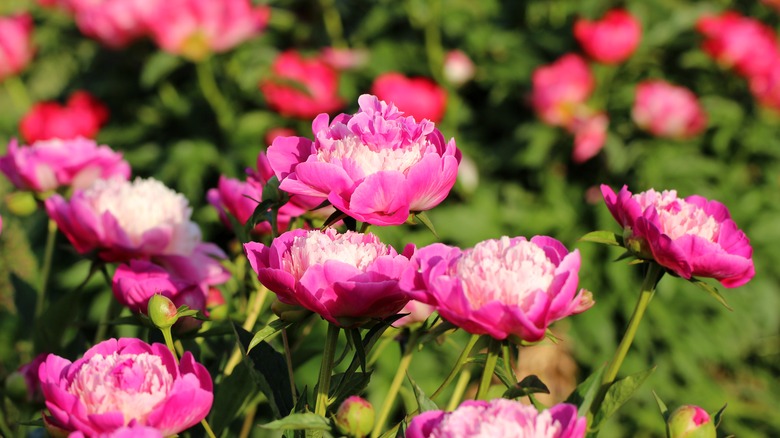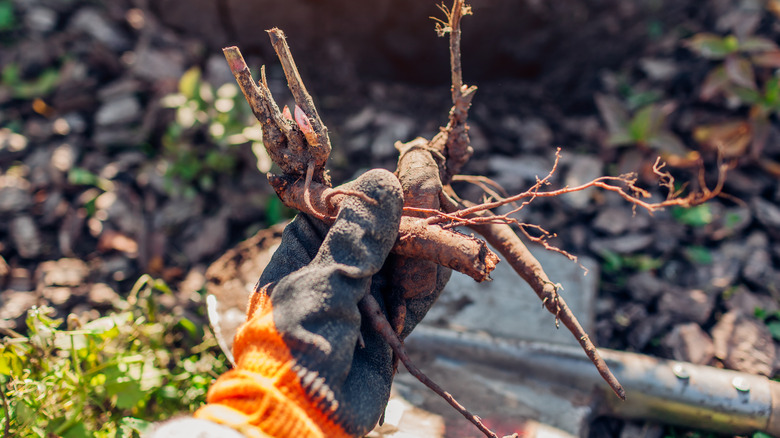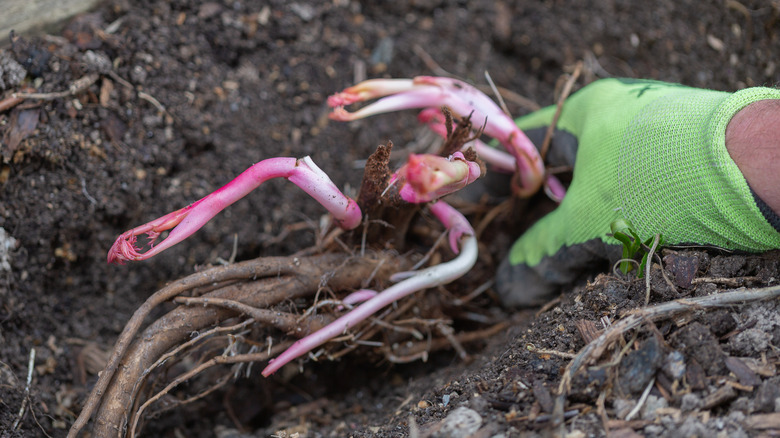How To Pick The Best Peony Roots For Your Garden (& To Maximize Beautiful Blooms)
In late spring, when the rather unassuming shrub produces small buds that explode into big, fluffy blooms, we're reminded of the timeless beauty of peonies. They come in a variety of colors, make excellent focal flowers in bouquets and arrangements, and they can live for over 100 years in the right spot. They conjure images of sprawling English gardens and rustic weddings, but they can make great additions to your own backyard too. Admittedly, while they don't require as much maintenance as some ornamentals, a bit of specialty knowledge goes a long way in helping your peony thrive.
Buying bare roots is one of the best ways to ensure quality before planting. Once you find a root or "bulb," you should inspect it closely. Look for at least three to five "eyes" on each root for the fastest bloom growth. The eyes are small buds on the larger root that will become the shoots. Also, make sure that the root itself isn't withered or rotting. While there are many mistakes everyone makes when planting peonies, buying bad roots doesn't have to be one of them.
Selecting a reputable peony root provider
Sadly, not all plant stock is equal, and that applies to plant suppliers. While you may be lucky enough to find your favorite variety in a big-box store, tucked into a plastic sleeve on a shelf, finding a reputable flower farm is an even better way to source quality products and support a small business. With the rise of the Slow Flowers movement, which provides resources for consumers looking for florists and flower farmers who grow in the U.S. and Canada, it is easier than ever to search online for peonies. The best time to start searching for sources is in spring or summer because you should plant your peony in the fall to get the most beautiful summer bloom. Many farms will cut off sales around September to ship to customers in October.
Your shopping experience will depend on whether you shop by color, type, or specific cultivar. But there are three common types of peonies: herbaceous, tree, and intersectional or Itoh. Though all three types are readily available to buy and grow, the most common for cut flowers are the herbaceous peonies, with blooms that burst open in a flurry of petals and foliage that dies back to the ground every winter. The Chinese peony, Paeonia lactiflora, is the most common, with several cultivars of its own, but it has also spawned several hybrid cultivars as well, which means plenty of colors and textures for you to choose from.
Inspect the roots for signs of pests
While there are plenty of tips to fight off common peony pests, nematodes can be an issue for the roots specifically. As a general guideline, big, healthy roots have the best chance of yielding healthy plants. Key details you should look for are firmness and the number of eyes, but you may also want to look out for odd lesions and lumps on the roots. These are signs of a possible nematode problem. Nematodes are microscopic worms that are not all bad guys. However, there are two species, Pratylenchus penetrans (root lesion nematodes) and Meloidogyne hapla (root knot nematodes), that can cause damage to the roots of several plant species, including peonies. Both can live in the soil that comes with the root. Damaged roots can have obvious swelling, knotting, or dark spots if the nematodes have been on the roots long enough, but lab testing is required to be 100% sure.
Once you have your healthy peony root in hand, the actual planting part is easy. With the eyes pointing up, focus on digging a wide hole, not a deep one. Peonies that are buried more than two inches deep don't bloom well. The entire root should be gently placed one to two inches deep, with tall eyes even poking out of the soil if they are long enough. Then like all new plantings, water them well for the first few weeks.


